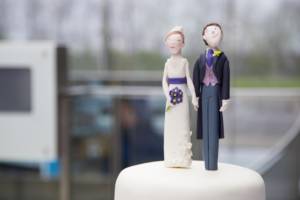
Wedding cake toppers remain a popular way to add a decorative touch and personal style to wedding festivities.
Cake toppers have stood on the summits of multilayered sugary wedding confections for several decades as both decorative touches and symbolic representations of happy newlywed couples. While sources disagree on when their use became widespread, they’ve become a staple at many nuptial gatherings both south of our border and here in Canada. This custom has remained as both an enduring tradition and an opportunity to express each couple’s ethos and personal style.
Origins in the United States
When did the first toppers grace wedding cakes in North America? It depends on who you ask. In their book “Cinderella Dreams: The Allure of the Lavish Wedding,” authors Cele Otones and Elizabeth Pleck mentioned that pairs of figurines representing newlywed couples came into use during the 1950s and were intended to embody the value of togetherness. Meanwhile, blogger Donna Sundblad places their origin before the United States Civil War, noting that affluent families were the first to adopt the trend.
According to Sundblad, the very first toppers usually consisted of flowers, bells or other small objects that represented the newlywed pair. They were typically handcrafted by a member of their families or sculpted by a professional baker with frosting, icing or plaster of Paris. The Smithsonian’s Museum of American History website exhibited a pair of figurines manufactured sometime in the middle or late 20th century, adding that they were more sophisticated and detailed in design than simpler toppers created in the early 1900s. As these decorations became more complex, they expanded to include versions with monogrammed initials, short phrases and shapes such as hearts, bells, bows and even half-moons.
Modern Interpretations of Cake Toppers
As times have changed, so have cake toppers. Sundblad gave one example in her blog post of groom figurines in military uniform becoming widely available for weddings during World War II. Also, the legalization of marriage equality in our country in 2005 translated into more LGBTQ individuals tying the knot. According to a Statistics Canada report, census figures from 2006 and 2011 revealed that the number of same-gender wedded couples almost tripled, rising to 21,015. With the changing demographics of Canada’s citizenry, merchants slowly began selling customized toppers to reflect the racial and ethnic backgrounds of the couples purchasing them as well as to provide options for same-gender wedded pairs.
These greater customization capabilities have also given rise to some new trends. Enterprising couples have gotten creative, using inspiration from pop culture and working with their bakers to craft unique cakes. As a result, many of them also pick toppers that integrate with or match the cakes’ designs. For example, it’s not unusual to see figurines dressed in Starfleet uniforms or Jedi robes. You might also see cake designs borrowed from popular fictional franchises such as Doctor Who, with its iconic time-traveling blue police box sitting atop these multilayered delights.
Top Tips for Your Toppers
Thinking of including a decorative touch on top of your wedding cake? The experts over at The Pink Bride dispense some important planning advice:
- Pick objects that complement your dessert’s overall look
- Make sure your topper fits your event’s theme
- Silhouettes, monogrammed toppers and food-safe flowers can be great choices
- Go for timeless over trendy if you’re saving the topper for future generations
Whether as a mode of quirky personal expression or as just one detail in a wedding’s overall theme and style, the popularity of cake toppers doesn’t appear to be diminishing anytime soon. Both brick-and-mortar and online vendors offer a wide range of products and personalization options from which couples can choose. While picking yours probably won’t be difficult, it’s vital to remember your cake’s design and your wedding theme when making your selection.


